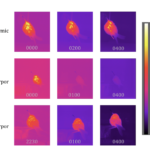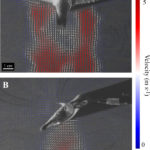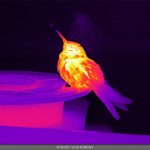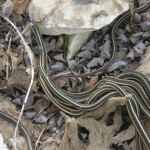![]()
Visit our YouTube page to see lab videos!
Physiological Effects of Warming Environmental Temperature on Hummingbirds
My lab has been exploring how hummingbirds respond physiologically to warming environmental temperatures resulting from climate change. This work is a continuation of a project initially funded by NASA entitled “Combining Remote-Sensing and Biological Data to Predict the Consequences of Climate Change on Hummingbird Diversity” involving several researchers from across the country. Our primary collaborators in this project have been Catherine Graham (Federal Research Institute WSL, Switzerland), Susan Wethington (Hummingbird Monitoring Network), Anusha Shankar (Tata Institute of Fundemental Research Hyderbad, India) and Bret Tobalske (University of Montana). Current work in this area continues in two primary areas:
- Heat dissipation during forward and hovering flight. Because hummingbird flight muscles have low mechanical efficiency extra heat is produced during both forward and hovering flight. At warm environmental temperature this can be an issue because the body plumage must remain in aerodynamic form. Our previous work shows that this extra heat must be dissipated through specific heat dissipation areas (HDAs) around the eye, shoulder, and legs where feather density is low (IR Video of Hovering Hummingbird ). This appears to be true for both passive and evaporative heat dissipation. When environmental temperatures are warm our current data suggests that these HDAs are insufficient for dissipation of all accumulated heat. My lab is engaged in answering questions related to how hummingbird deal with the need to dissipate this when environmental temperature is high.
- Nocturnal body-temperature management by hummingbirds. After measuring nocturnal metabolic rate in several species of hummingbirds under semi-natural conditions in both Arizona and Ecuador it became clear that bouts of hypothermia associated with torpor were more complicated than a dichotomy between normothermy and deep torpor. Based on continuous imaging of
 hummingbirds in southeastern Arizona using an infrared video camera we found that our study species were all capable of using a more shallow form of nocturnal torpor. Going forward my lab will address questions related to how frequency and duration of shallow torpor might change as nights become warmer, and how this might impact overall energy savings at night, and how use of shallow torpor might allow for physiological restoration (e.g. real sleep) which is not likely possible in deep torpor.
hummingbirds in southeastern Arizona using an infrared video camera we found that our study species were all capable of using a more shallow form of nocturnal torpor. Going forward my lab will address questions related to how frequency and duration of shallow torpor might change as nights become warmer, and how this might impact overall energy savings at night, and how use of shallow torpor might allow for physiological restoration (e.g. real sleep) which is not likely possible in deep torpor.
Hummingbird flight energetics and biomechanics
My lab is currently exploring questions associated with how a hummingbird’s unique anatomical design impacts the biomechanics of flight and the associated energetic cost. Our approach involves laboratory studies where flight conditions are controlled in a wind tunnel and field studies of hovering flight currently being conducted in southeastern Arizona. Recently we have expanded our laboratory work to include studies of heat balance during flight using high-speed infra-red imaging. Key collaborators in this work are Dr. Bret Tobalske, University of Montana, Dr. Doug Warrick, Oregon State University, and Dr. Susan Wethington, Hummingbird Monitoring Network.
anatomical design impacts the biomechanics of flight and the associated energetic cost. Our approach involves laboratory studies where flight conditions are controlled in a wind tunnel and field studies of hovering flight currently being conducted in southeastern Arizona. Recently we have expanded our laboratory work to include studies of heat balance during flight using high-speed infra-red imaging. Key collaborators in this work are Dr. Bret Tobalske, University of Montana, Dr. Doug Warrick, Oregon State University, and Dr. Susan Wethington, Hummingbird Monitoring Network.
Reproductive energetics of the red-sided garter snake (Thamnophis sirtalis parietalis)
In collaboration with Dr. Bob Mason and Dr. Chris Friesen my lab is exploring questions associated with the reproductive energetics of red-sided garter snakes (T. sirtalis parietals) with specific interest in male-male competition for females and female energetic cost during courtship and copulation. We have conducted in the past experiments that explore how body size (male and female) and mating-group size impact reproductive costs. This past season our experiments explored the cost of male copulatory plug production contributes to a male’s energetic costs and how the cost of plug production might be impacted by male body size.. T. sirtalis parictalis is particularly interesting because of the high concentration of males that are competing for a few females when they emerge from hibernation.




